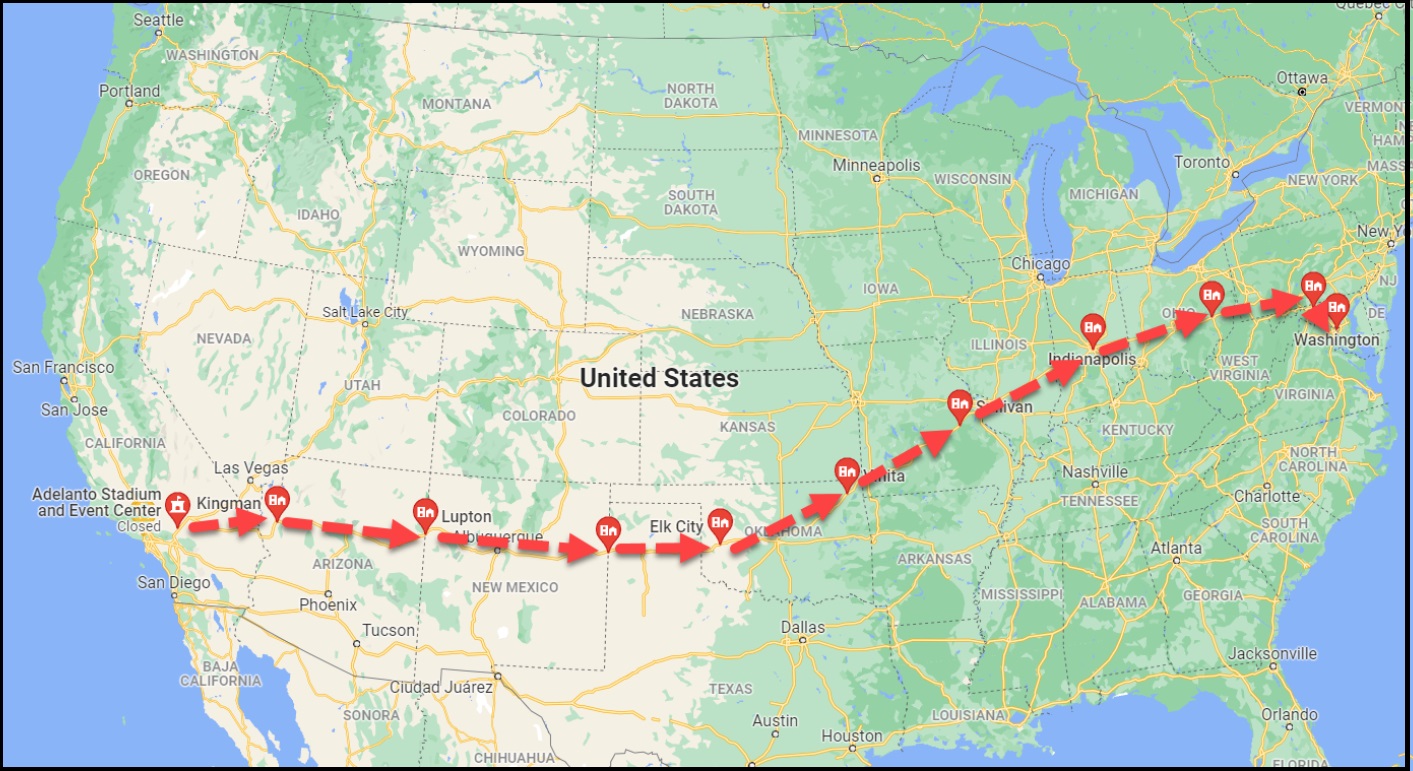
Wednesday, February 23, 2022
Biden Approval Rating In Ukraine Drops To 0%

Day 1 of The People's Convoy
Source: https://www.thegatewaypundit.com/2022/02/first-group-truckers-reaches-bidens-backyard-massive-peoples-convoy-begins-journey-nations-capital-videos/
The American truckers have officially begun their descent on Washington DC.
The first of multiple trucker convoys was spotted in Biden’s backyard on Wednesday as the DC Swamp continues to scramble in preparation for the massive protest that will be arriving over the next few days.
The group of 30 or so vehicles was led by Bob Bolus, who is the owner of a Pennsylvania trucking company. Bolus spoke with Fox News and said his group left Scranton on Tuesday kick the protests off and send a message to Lawmakers that we aren’t waiting around anymore – the people are fed-up.
“We’re the tip of the arrow right now,” Bolus said.
Bolus explained to Fox News:
“What they’re seeing today is just a prelude of what’s going to come if they don’t sit down and listen to us and get rid of these restrictions. Because then we’ll shut the country down. We control this country. Not the government.
It’s taken out rights. It’s taken everything America stands for. We’re just simply saying, the rights they took, to simply reinstate them.”
The DC media was tracking Bolus’ convoy into town and even fired up the press helicopter to watch its movements as it got closer.
This is going to get really interesting once more protesters come to DC. After all, like Bolus said, this is just a “prelude” – the fake news media will be kicked into full overdrive in the coming days.
Watch:
Several other groups of truckers from all areas of the country are also planning on arriving throughout the week in order to form a massive demonstration similar to the one recently seen in Ottawa.
Just hours before the first trucks began arriving in Washington, DC, ‘the People’s Convoy’ kicked off its journey from California to the Nation’s Capital in stunning fashion, with thousands of people showing up to send them on their way.
Videos from the send-off event show countless cars parked and lined up around Adelanto Stadium in California. Supporters brought food, drinks, and essentials for the convoy participants to ensure they had everything needed for the upcoming standoff.
Hat/Tip to independent journalist Brendan Gutenschwager was on the scene and documented everything.
Watch:
Just take a look at the crowd hours before the event started. It was a packed house!
Event organizers had a stage and spoke for about an hour to the crowd about their plans and motivations for traveling to Washington.
After the speakers finished, it was time for the trucks to roll out. Dozens of trucks lined up into position and poured out onto the open road to begin the eleven-day journey.
There are reportedly 1,000 vehicles ready to go out of the gate, with countless more joining or meeting them in DC.
EPIC!
Watch:
Hundreds of vehicles, including RVs and trucks, also followed the convoy out of the arena.
Not all of them are traveling with the convoy, but a large number of them are.
Judging by the number of cars though, especially considering this is in California, this convoy going to be massive by the time it ends its cross-country journey.
Next stop, Kingman, Arizona.
Honk Honk!
USA Freedom Convoy Departs California, Let’s Roll America Ground Report, Detail and Links for Updates
Early this morning, The People’s Convoy [Facebook Page Here] departed for a 10-day freedom convoy from California to DC. The final stop is in Hagerstown, Maryland. Friend of the Treehouse, John Spiropolous is traveling with the convoy and will be sharing ground reports along the route.
Facebook Page ~ Official Convoy Website Here ~ Press Release pdf Here
The truckers will drive anywhere from a minimum of 216 miles a day to 375 miles a day. Travel times daily range from a minimum of three and a half hours of driving to a maximum of five and three quarters hours of driving a day. Today they departed from Adelanto Stadium, CA, and will arrive in Kingman, AZ for overnight stay. John was with the convoy as they prepared and departed, WATCH:
As John Spiropolous notes, “obviously, an individual trucker can make it from California to DC a lot faster. But for safety and security reasons, coordinating what they expect to be thousands of truckers, they’re going to take their time. My own opinion is that like that old phrase, “Life is a journey, not a destination,” the convoy’s message is the journey. The convoy gets 10 days of publicity. And with no intention of going into DC, much less encircling the Capitol, they’ll avoid a J6 type false flag op.”
Quoting the press release. “The People’s Convoy will abide by agreements with local authorities, and terminate in the vicinity of the DC area, but will NOT be going into DC proper.” The trip should take approximately 10 days. 2,533 miles.
“The message of The People’s Convoy is simple. The last 23 months of the COVID-19 pandemic have been a rough road for all Americans to travel: spiritually, emotionally, physically, and – not least – financially. With the advent of the vaccine and workable therapeutic agents, along with the hard work of so many sectors that contributed to declining COVID-19 cases and severity of illness, it is now time to re-open the country.
The average American worker needs to be able to end-run the economic hardships of the last two years and get back to the business of making bread – so they can pay their rents and mortgages and help jumpstart this economy. To that end, it’s time for elected officials to work with the blue collar and white-collar workers of America and restore accountability and liberty – by lifting all mandates and ending the state of emergency – as COVID is well-in-hand now, and Americans need to get back to work in a free and unrestricted manner.” (LINK)
Former DC journalist and ally of the Rebel Alliance, John Spiropoulos, is part of a 4-person team (2 reporters and 2 cameramen) covering the 2,500 mile event. He will be sending daily videos during the trip which will be far better than mainstream media reports.
If you would like to support John’s reporting of the convoy and help defray the costs and expenses, he has a GiveSendGo crowdfunding account set up:
GiveSendGo – Let’s Roll America
John previews what to expect:
The People’s Convoy Route*
*Route subject to change

Day 1: Wednesday, February 23
Morning – Depart Adelanto Stadium, CA
Evening – Arrive in Kingman, AZ for overnight stay
Day 2: Thursday, February 24
Morning – Depart Kingman, AZ head east on I-40, toward Lupton, AZ
Evening – Arrive in Lupton, AZ for overnight stay
Day 3: Friday, February 25
Morning – Depart Lupton, AZ on I-40 eastbound thru New Mexico
Evening – Arrive in Glenrio, TX for overnight stay
Day 4: Saturday, February 26
Morning – Depart Glenrio, TX
Evening – Arrive in Elk City, OK area for overnight stay
Day 5: Sunday, February 27
Morning – Depart Elk City, OK area
Evening – Arrive in Vinita, OK area for overnight stay
Day 6: Monday, February 28
Morning – Depart Vinita, OK area
Evening – Arrive in Sullivan, MO area for overnight stay
Day 7: Tuesday, March 1
Morning – Depart Sullivan, MO area
Evening – Arrive in Indianapolis, IN area for overnight stay
Day 8: Wednesday, March 2
Morning – Depart Indianapolis, IN area
Evening – Pause for rest in Indianapolis, IN area for overnight stay
Day 9: Thursday, March 3
Morning – Depart Indianapolis, IN area
Evening – Arrive in Cambridge, OH area for overnight stay
Day 10: Friday, March 4
Morning – Depart Cambridge, OH area
Evening – Arrive in Hagerstown, MD area for overnight stay
Day 11: Saturday, March 5
Morning – Depart Hagerstown, MD area
Evening – Arrive in the DC Beltway area
The People’s Convoy will abide by agreements with local authorities, and terminate in the vicinity of the DC area, but will NOT be going into DC proper.
COVOY Details and Support Links HERE
Support John Spiropoulos HERE
Where Did Our Freedom Go?
In the 2000s, when I was in high school, civil disobedience was lauded as something almost inherently noble. Our teachers encouraged us to think like Rosa Parks or Martin Luther King, Jr., and grow up to be the kind of people who would disobey unjust laws. The moral groundwork for this philosophy, though our teachers were almost certainly ignorant of the fact, was the very American idea that Benjamin Franklin proposed as the motto for the United States: “Rebellion to Tyrants is Obedience to God.”
Our teachers, though, came at the problem from a different perspective. They were a remnant of the hippie movement of the 1960s and ’70s. A movement which, like the teachers themselves, never quite attained intellectual maturity. Their desire to challenge authority and “the man” was based not on a moral commitment to freedom which Franklin would have recognized, but simply on a desire to be the authority themselves.
A true liberal and a power-hungry thug look similar when they’re in opposition. The French Revolutionaries began by patterning themselves explicitly after their American cousins. But whereas Washington rejected the proffered crown, Robespierre very much desired to be king. As did many of the comrades Robespierre killed—and those who finally killed him.
Fidel Castro in the jungle seemed like a democrat to many. American taxpayers (via the CIA) supported his movement with a gift of $50,000. Then it turned out Castro’s goal was the same as Batista’s—to be a dictator—and the CIA had to spend the next five decades trying to kill him. We learned from this experience by later sponsoring, and on a vastly larger scale, that great lover of democracy, the mujāhid Osama bin Laden.
Should we be surprised when all the “liberals” in Australia, New Zealand, Canada, and the United States turn out to be fascists in disguise? Should we be surprised that what they truly desire is to exert unlimited power over the lives of others? Of course not. The abuse of power, once power is attained, is practically universal. George Washington rejected absolute authority, and Cincinnatus returned it to the Roman Senate after just 15 days. But in every single other case in history, a dictator remains a dictator until he or his dynasty is killed off.
We are entering the post-Western democracy stage of history. And we’re further along than we thought. No one was shocked when Germany or Austria locked people in their homes during COVID—democracy in a European nation-state has always been a thin veneer. But it was shocking to read of people attempting to climb the fences at Australian COVID concentration camps and being hunted down by the police. It was shocking to see Canada’s party-line vote to prolong emergency powers so they can make protests illegal, imprison political enemies, and confiscate dissenters’ property.
The big surprise isn’t that the Western world is giving up its freedom: The surprise is that freedom is already gone and nobody knows exactly when or where it went. The voters in these countries spent decades not paying attention to each incremental expansion in government power and taxation, until they finally looked at the balance in their political bank accounts this week and discovered someone had run away with all the funds.
Where did the freedom go? It was swallowed by the cities.
For at least the last 10 years in America, and maybe closer to 20, only the cities have had a say in state government. Consequently, only the cities wield power on a national level. Most people live in cities now—a danger which the founding fathers foresaw but didn’t know how to prevent. Jefferson wrote to Madison that when our governments “get piled upon one another in large cities, as in Europe, they will become corrupt as in Europe.”
All our protections against the abuse of political minorities’ rights assumed a more-or-less even distribution of political sentiment across the nation. No one had a good answer to the problem of a tyranny of cities over the countryside. Yet it’s a problem we should have been thinking about: The French Revolution was a tyranny of Paris over the Vendée. The Soviet Revolution was a tyranny of Moscow over the farmers in the Ukraine. And still, we never considered what to do with a tyranny of New York and Chicago and San Francisco over our own countryside. An hour north of Hartford, Connecticut, people are as just as traditionally American as anyone you’ll meet in South Carolina or Texas. But they have no say over the laws that govern them.
The Canadian truckers’ protest is really a proclamation by Canada’s countryside: “We don’t have any control over our own lives!” To which the cities respond: “Darn right you don’t!”
Trudeau Revokes His Use of the Emergencies Act
Source: https://www.thegatewaypundit.com/2022/02/breaking-shocking-reversal-trudeau-revokes-use-emergencies-act-video/
Just two days after the Canadian Parliament voted to uphold his unprecedented use of the Emergencies Act, Prime Minister Justin Trudeau announced that he has revoked the measure completely in a press conference on Wednesday afternoon.
The sudden decision to give up his emergency powers, which were set to remain for at least the next three weeks, is an unexpected one, to say the least. After all, Trudeau has employed the Emergencies Act for the past 10 days and has utilized the near-limitless powers to terrorize and harass the grassroots trucker convoy protests, so it’s not like he had a sudden change of heart all of a sudden.
However, Trudeau now says that the “emergency” is over. So, what changed over the past 48 hours?
Trudeau announced the decision:
“We’re ready to confirm the situation is no longer an emergency. Therefore, the federal government will be ending the use of the Emergencies Act. We are confident that existing laws and bylaws are now sufficient to keep people safe. of course, we will continue to be there to support provincial and local authorities if and when needed.”
Watch:
This is a developing story. Check back for updates.
Unbridled Presidential Power and Executive Actions
Government intervention into the day-to-day lives of American citizens has reached new heights in recent years, corresponding to a monumental increase in the power of the executive branch.
Our country draws its strength from the potency of our democratic institutions, protected by the Constitution. The principle mechanism by which our founders ensured the survival of our nascent democratic tradition was the separation of powers.
The first of these power demarcations occurs along the federal versus state spectrum. James Madison—one of the foremost authors of our Constitution and ardent champion of the Bill of Rights—wrote in Federalist 45:
The powers delegated by the proposed Constitution to the Federal Government, are few and defined . . .The powers reserved to the several States will extend to all the objects, which, in the ordinary course of affairs, concern the lives, liberties and properties of the people; and the internal order, improvement, and prosperity of the State.
But states’ rights have been consistently abrogated by the federal government, especially throughout the COVID-19 pandemic.
Yet, the second and perhaps more important demarcation falls between the three principal branches of our federal government: the legislative, judicial, and executive branches—with each intended to check the other two. In this, the founders were inspired heavily by the French philosopher Montesquieu, who wrote extensively of the importance of this separation: “Were the power of judging joined with the legislative, the life and liberty of the subject would be exposed to arbitrary control, for the judge would then be the legislator. Were it joined to executive power, the judge might behave with all the violence of an oppressor.”
Judge Andrew Napolitano recently wrote about this in the context of America, “If the president wrote laws, the courts would invalidate them; if the Congress interpreted laws, the president and the courts would ignore it; if the courts hired folks to enforce laws, the Congress would not fund their salaries.”
Unfortunately, despite the efforts of our founders, this latter demarcation has been consistently eroded as well.
The executive branch has increasingly outmaneuvered its power constraints by utilizing executive actions—specifically executive orders and memoranda—which pose a substantial threat to our democratic institutions.
Executive actions, in particular, have received significant recent attention, as they have been the primary vehicle for the Biden Administration’s overreach in response to COVID-19. And, though the Supreme Court has held the line in certain areas—such as striking down Biden’s vaccine mandate on large employers—it was unable to use its vested power of judicial review upon the accompanying executive orders governing Medicare and Medicaid-funded facilities.
As of February 16—barely one year into his presidency—Biden has signed 80 executive orders, putting him on pace for more than 300 by the conclusion of his term in office.
To be fair, it is true that President Trump was at least partially guilty of a similar tendency, having signed 220 orders during his presidency. But, it is important to remember that many of Trump’s executive orders were simply revocations of Obama Administration orders.
Moreover, Trump had to overcome substantial partisan gridlock. Biden does not have this problem, as Democrats control both chambers of Congress, representing yet another reason his overreach has been particularly egregious.
Though Trump does bear some culpability for setting a precedent for executive action, it is overwhelmingly Democratic presidents who have resorted to pushing their agendas through unilateral orders.
Let’s take a look at the average annual executive order count for presidents since the establishment of the Federal Register Act of 1936.
- Roosevelt (D): 307 per year
- Truman (D): 117
- Eisenhower (R): 61
- Kennedy (D): 75
- Johnson (D): 63
- Nixon (R): 62
- Ford (R): 69
- Carter (D): 80
- Reagan (R): 48
- Bush Sr. (R): 42
- Clinton (D): 46
- Bush Jr. (R): 36
- Obama (D): 35
- Trump (R): 55
- Biden (D): 77
The numbers speak for themselves. Averaging the number of orders per president yields exactly 100 per year for Democrats, and approximately 53 for Republicans. Though this is partially skewed by Roosevelt’s outlier, it is still a substantial disparity.
Biden’s high count is especially troubling when one keeps in mind that Democrats may very well lose control of at least one chamber of Congress in the upcoming midterms, potentially pushing him further towards unilateral policy decisions.
Executive memoranda are equally insidious, if not more so. They are so similar to executive orders that presidents have mixed them up; one presidential scholar writes that they are “executive orders by another name, and yet unique.”
Their uniqueness seems to revolve around their general lack of transparency and related suitability for surreptitious executive policy decisions.
There are three primary differences, all of which are concerning. According to the Library of Congress:
- Memoranda are not numbered, nor does law require them to be published in the Federal Register.
- They are not required to cite the president’s legal authority.
- The Office of Management and Budget (OMB) is not required to issue a Budgetary Impact Statement.
If memoranda are not numbered or published, where can we find an accurate record both of the number and substance of these memos? A perusal of the Federal Register does not elicit a clear accounting, neither does the White House supply it.
If memoranda are not required to cite the president’s legal authority, how can the Supreme Court exercise judicial review, especially if they are unaware of many memoranda’s existence?
Moreover, if the OMB is not required to estimate budgetary impact, how can Congress be certain the money it has allocated is being spent according to its wishes? How can the public know for certain where its tax dollars are being spent?
Little of the above inspires much confidence. With COVID-19 finally drawing its last breaths, now is the time to rein in the executive branch, before it establishes further precedent for power accumulation by future administrations.
In the dog-eat-dog world of French politics
In the dog-eat-dog world of French politics, Clovis (aka "Douglas"), who lives in the Nice region, managed to register and cast his vote at Les Republicains' primary election. Clovis is actually... a dog.
The Ukraine Crisis Is A Direct Result Of Biden’s Weak Foreign Policy
It’s hard to imagine a weaker, more impotent response to Moscow’s move against Ukraine than what the Biden administration announced Monday evening: an executive order imposing limited sanctions on two separatist regions of eastern Ukraine, the so-called Donetsk People’s Republic and Luhansk People’s Republic. The sanctions are a response to the Kremlin’s decision Monday to recognize these rebel-held regions as independent states. Early Tuesday morning, Russia deployed troops to these areas, calling them “peacekeepers.”
In a statement, the White House said the sanctions on Donetsk and Luhansk are separate from the “swift and severe economic measures” it would impose on Moscow, “should Russia further invade Ukraine.”I’m sure Vladimir Putin is quaking in his boots. No further invasions, sir! That’s quite far enough.
More than anything, these incredibly unimportant sanctions from President Joe Biden underscore how the entire humiliating Ukraine crisis is a direct result of Biden’s weak foreign policy and feckless appeasement of Russia over the past year. A robust policy of deterrence, like maintaining the Trump administration’s sanctions on the Nord Stream 2 pipeline that Biden waived last May, might have prevented the crisis.
But now it’s too late. The thing about deterrence is that you have to use it before your opponent makes his move. Russian forces are now on the ground in eastern Ukraine, and they’re probably there to stay. The time to get tough on Moscow and prevent a clash with Ukraine has passed. Sanctions, whether from the U.S. or from the European Union, are not going to force Putin to change his mind and retreat. Instead, these half-measures will give us the worst possible outcome: all the downsides of an actual military conflict, which is now certain, without the preceding benefits of deterrence.
What might those benefits have been? For one thing, we might have forced Putin to narrow the scope of his ambitions vis-à-vis Ukraine and engage in a negotiated settlement to the standoff — not because Putin wanted that, but because we made him understand that that’s all we would give him.
Too bad Biden’s team came into office and, by dropping Nord Stream 2 sanctions, immediately signaled to Putin that now was the time to press his longstanding aims in Ukraine. The pity of it is that the Ukraine crisis represented a rare possibility for a negotiated settlement in which all parties got some of what they wanted.
Indeed, the situation of Ukraine is historically unique. As Paul Pillar of Georgetown University has written: “The unusual circumstances of the historical Russian connections with Crimea and Nikita Khrushchev’s transfer of the territory’s administration from one subordinate unit of the USSR to another, followed many years later by achievement of independence by those units, does not really have an equivalent elsewhere.”
Given this history, my friend Mario Loyola has argued in these pages recently that with its current borders Ukraine can have territorial integrity or political independence, but it can’t have both. Remember, Ukraine’s present-day borders are the result of the sudden collapse of the Soviet Union in 1991, which had some forty years earlier given Ukraine artificially enlarged borders, including Odessa and Sevastopol, Russia’s most important commercial and naval ports. Once Ukraine broke from Moscow in 2014, its 1991 borders became untenable — and everyone, including the Ukrainians, knew it. Russia was never going to accept a westward-oriented Ukraine, still less NATO membership for Ukraine.
Admitting that, says Loyola, doesn’t amount to appeasement, and in fact it opens the way for a negotiated settlement:
Russia has continued to be a malign force in world affairs. But not all its grievances are unreasonable, and it is a dangerous mistake for Kiev and Washington to reject them all out of hand.
The United States and its NATO allies should recognize Kiev’s decision to prioritize political independence over territory, for it helps clarify the outlines of a peaceful settlement. The Ukraine crisis can’t last forever. And while Russia surely knows it can’t have everything it wants, if it gets some of what it vitally needs, perhaps Ukraine can, too.
But for any of that to happen, the United States needed to have a firm, steady hand in its dealings with Moscow. In this, Biden failed miserably, coming into office with a lot of bluster about how he was going to take a firm line on Putin, that he alone knew how to deal with Moscow. During the 2020 campaign, Biden even suggested, ludicrously, that Putin didn’t want him to become president because of how tough Biden would be on him.
The whole thing is reminiscent of the Obama administration’s handling of the Syrian civil war. Not just the weakness of President Obama’s embarrassing “red line” fiasco but also his refusal to do anything militarily to weaken the Assad regime before calling for a negotiated settlement.
The draft Syria resolution that the Obama White House sent to Congress in August 2013 authorized military force in connection to the use of chemical weapons but not in connection to any long-term U.S. goals in Syria, like a negotiated settlement that saw Bashar Assad removed from power. At the time, Assad’s removal was the stated policy position of the Obama White House. But by separating military force and a negotiated political settlement, as if the two could not work together, Obama guaranteed that any military force that was authorized would not alter the facts on the ground, and therefore would not weaken Assad’s position going into negotiations.
In the end, there were no negotiations because Assad never had need for them. He knew that the U.S. and its allies would not authorize military force sufficient to change the reality on the ground, so he crushed the rebel forces, killing a half-million of his own countrymen in the process.
In Ukraine, we now have a similar dynamic playing out, with the Biden administration calling for sanctions and international pressure after Moscow has already made its move. The time to put pressure on Putin and declare that an invasion of Ukraine would be a “red line,” has passed. Now, Biden is reduced to haggling publicly with our European allies over sanctions that will certainly be watered down given Europe’s energy dependence on Russia. Whatever they come up with, it will do very little to alter the facts on the ground, and do nothing at all to deter whatever additional plans Putin has for Ukraine.











